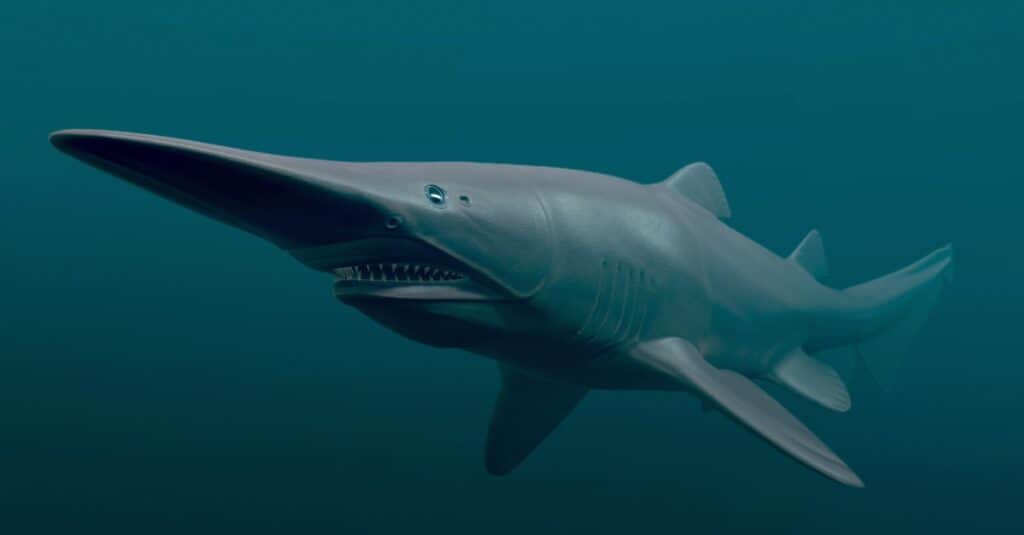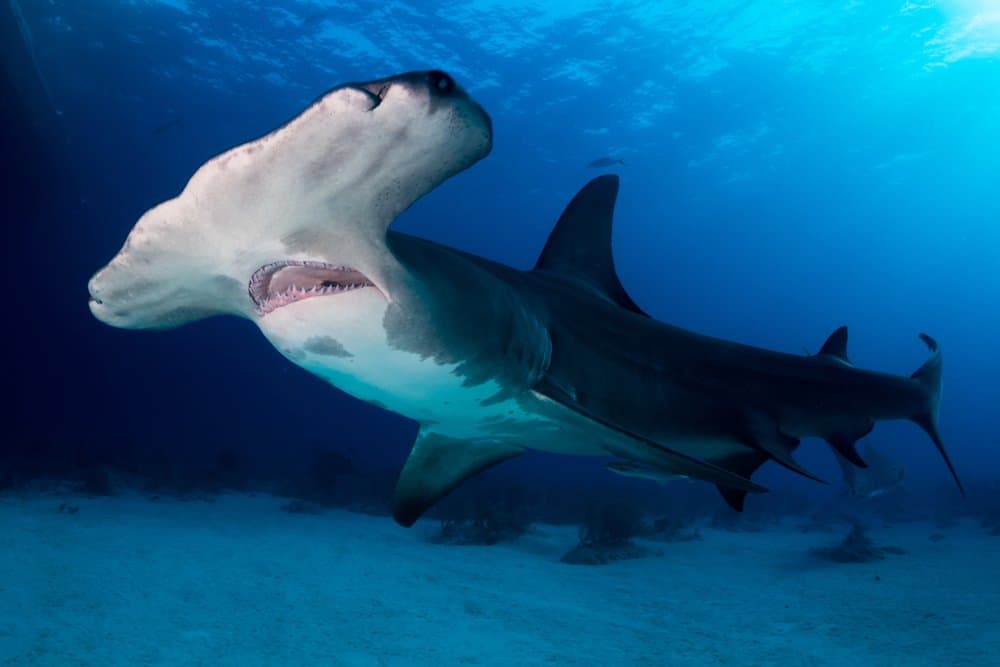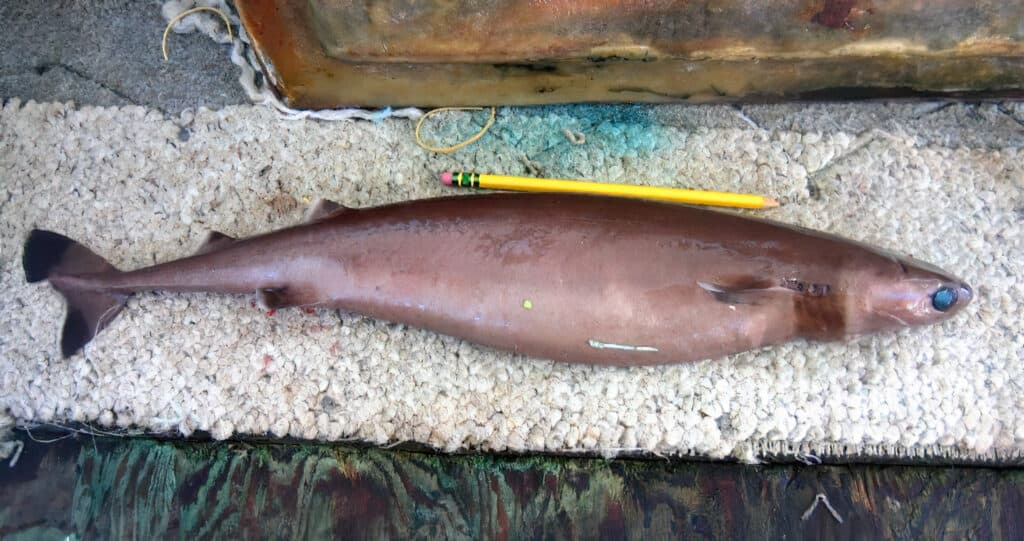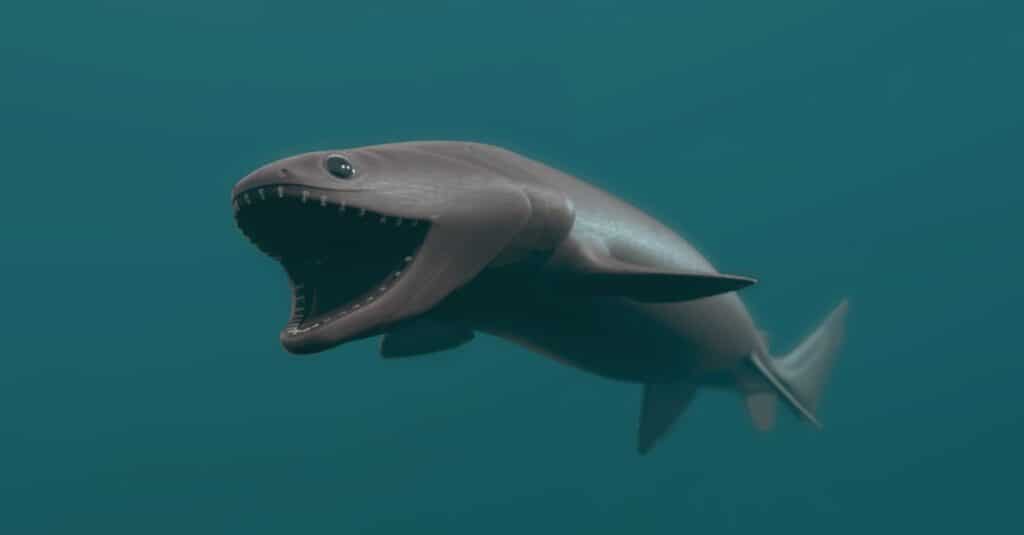Over the years, many species of sharks have been discovered, each with its unique features or looks. Yet, just when you think you have met them all, yet another beautiful (or not so beautiful) weirdo pops up. There are over 500 discovered shark species, and (surprise!) not all of them have the typical appearance of a big body and several needle teeth.
Some of these species develop really cool features like sharks that glow in the dark, and sharks that have their own power tools! Below are some sharks we consider strange enough to earn a place on our list of the 9 weirdest sharks discovered so far. You will discover some pretty amazing, and almost unbelievable sharks in this article. Ready? Let’s go!
Greenland sharks

Greenland sharks were once killed and used to make machine oil.
©Dotted Yeti/Shutterstock.com
Greenland sharks are quite massive and carry the typical intimidating appearance of predators. They have been known to grow as long as 21 feet and weigh up to two thousand pounds. Huge, right? Although Greenlands can intimidate almost any sea animal by their size, they do not attack humans. In fact, they are incredibly stealthy and blend into their natural habitat.
They like to live in very cold waters and scavenge on any meat they can find. Greenlands move rather slowly, compared to other sharks, and are one of the oldest living sea creatures.
Despite the fact that their flesh contains neurotoxins that are potentially dangerous to humans, Greenlands are a delicacy in Iceland. The poison is neutralized through a fermentation process that involves hanging the fish for a couple of months. The Greenland shark is also called a gurry shark or a gray shark.
Megamouth shark

Megamouth sharks weigh up to 2600 pounds.
©Opencage / CC BY-SA 2.5 – License
Megamouth sharks actually have mega mouths. You may be able to identify them by the distinct size of their mouths. This peculiar outlook is due mainly to how they feed. Megamouths are filter-feeding planktivorous sharks. This means that they mostly eat plankton. Because they do not have teeth, megamouths swim with their mouths open and filter in plankton from the water. This means that animals like krills are likely to fall right into a mega’s mouth without warning! Megamouths were discovered much recently but are known to grow quite big. The average size of discovered megamouths is about 13 feet, and they weigh up to 2600 pounds.
Goblin sharks

The goblin shark is scary given its size of over 12 feet.
©iStock.com/3dsam79
Now, here is where we put a face to the word weird. Goblin sharks do not look like typical sharks. Apart from the fact that they don’t grow to be so big, their skin comes in a pinkish shade. When fully grown, their weight is usually about 400 pounds, and they can be as long as 13 feet or more. Although they’re not very pretty to look at, there are a number of interesting things about these sea goblins.
One of its most peculiar features is a long snout, shooting in front of its head like a blade. Interestingly, this snout gets smaller as the shark grows older. Goblin sharks also have strong jaws which they can extend outwards to catch their prey. They are bottom feeders, so they can only be found in far depths of the ocean.
Hammerhead shark

The position of the
hammerhead shark
‘s eyes gives it a much better vision than any other shark.
©HakBak/Shutterstock.com
Hammerhead sharks are famous for their signature look: a horizontally shaped head with their eyes on either end like the two edges of a hammer or a T. They are quite fascinating to look at, and can be seen along coastlines. Hammerheads can grow to be very large. Their size varies between 11 inches and 24 inches in length and they can weigh up to a thousand pounds in weight. The position of their eyes gives them a much better vision than any other shark. They also have an excellent sense of distance, which helps them when they go lone hunting at night.
Megalodon

Estimated to be 59 feet long, the
Megalodon
was one of the biggest and largest fish to ever exist.
©Warpaint/Shutterstock.com
The Megalodon was the biggest shark to have ever lived. Although this species is now extinct, it is worth a mention because of its massive size. This shark was estimated to be 59 feet long, with an enormous appetite. That’s about the length of a bowling lane, or ten standard refrigerators, or a five-six-story building!
Fossil evidence shows that the Megalodon ate almost anything including whales, sharks, and turtles. Given its size, the Megalodon would be able to take down almost any sea creature and be hunted by none.
Wobbegong sharks

Tasseled wobbegongs are ambush predators who prey on schools of fish and can attack humans unprovoked.
©frantisekhojdysz/Shutterstock.com
Speaking of sharks whose appearance do not look shark-like, here we have the wobbegong. Its name is derived from an Australian word that means “shaggy beard.” This is because wobbegongs have lobes or tassels around their mouths which give them a bearded look. They are also called “carpet sharks” because of the beautifully patterned markings on their body. Their skin gives them the perfect camouflage on the ocean floor.
Wobbegongs are known to lie still, creating the perfect ambush for reef fishes and sometimes smaller sharks who come near. You may agree that this method is a little unusual for sharks who are usually confrontational. It goes to show that each species is rather unique.
Cookiecutter shark

Although they only grow up to 22 inches, cookie-cutters have a habit of going after much bigger animals like
great white sharks
.
©NOAA Observer Project / public domain – License
Cookiecutter sharks are peculiar for two main reasons; the shape of their jaws and their interest in much bigger sharks despite their size. These sharks have round jaws with many sharp teeth. Because of the way their mouths are shaped, they often leave cookie-sized holes when they bite other animals or even people. Although they only grow up to 22 inches, cookie-cutters have a habit of going after much bigger animals like great white sharks! They are known to swim toward the surface to take bites of orcas and other sharks.
Viper dogfish shark
These sharks are nearly as odd as goblin sharks. Although they don’t have snouts, they have protruding jaws with mean-looking teeth. Viper dogfish don’t have much by way of size, as they only grow to be 7 to 21 inches long. Apart from their strange appearance, viper dogfish make this list because they can glow in the dark! Their undersides have photophores which give them the ability to light up. This skill is an advantage against predators and prey alike. The glow helps them blend in with sunlight from the surface. So, predators below will likely miss them. At the same time, this lighting can attract prey animals such as small fish.
Frilled shark

Although frilled sharks are not very common, they live in depths of 65 feet to 4900 feet in the Atlantic and Pacific Oceans.
©iStock.com/3dsam79
Frilled sharks look more like a reptile than a shark. They have several rows of pointed teeth, which can be up to 300 at a time! Frilled sharks have their gills shaped like frills, and they extend from the sides of their mouth to their throat. Their length is usually about 4 feet, and can take on squids or other fish that are larger than they are. Although frilled sharks are not very common, they live in depths of 65 feet to 4900 feet in the Atlantic and Pacific Oceans.
The photo featured at the top of this post is © Vladimir Wrangel/Shutterstock.com
Thank you for reading! Have some feedback for us? Contact the AZ Animals editorial team.






